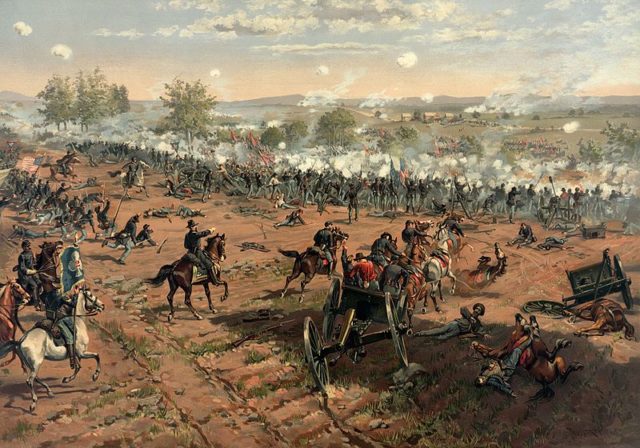Although it rarely gets the spotlight or any attention at all, cleanup after a battle is a gruesome task. There are bodies, both dead and wounded, to take care of, and weapons to gather. The Battle of Gettysburg was no different.
The conclusion of the Battle of Gettysburg saw the Confederate Army in full retreat, forced to abandon all of its dead and most of its wounded. This left the Union Army and the local citizens with the job of cleanup. It was when the weapons were being gathered and added to a master list of enemy possessions found that people started to notice something strange.
The numbers we have today state that at least 27,574 rifles were recovered, although some sources claim the number to be as high as 37,000. Of the weapons that were salvaged, an incredible 24,000 rifles were still loaded (that’s either 87% or 63%, depending on which estimate you accept.) Of the total number, half had been loaded more than once, and a quarter had been reloaded multiple times. Apparently, one poor soldier had reloaded his weapon twenty-three times, but the weird thing is that he never fired a single shot.
Read that again: he reloaded his weapon, but didn’t shoot at all, and he wasn’t the only one to do this. Now at first glance, this doesn’t make any sense. However, there are some theories to explain this strange occurrence. One theory suggests that the soldiers, for whatever reason, were not firing, but wanted to appear as if they were participating in the volleys. The deception would work too. In that situation, there would be thick smoke, mass confusion, and deafening sounds of weapons discharging. A soldier would not be likely to notice even if it was his neighbor in the firing line was not shooting. All a person would have to do would be to mimic the motion of kickback as they pretended to fire.

This theory, as well as a possible reason, can be found in Dave Grossman’s book On Killing, which details the psychological impact of killing in war. He came to the conclusion that the soldiers might have been unable or unwilling to shoot at the Union Army. Instead, they would have intentionally fired over the heads of their enemies or would have double-loaded their weapons so that they were unusable. Another author who uses this theory is Paddy Griffin. In her book, Battle Tactics of the Civil War, Griffin suggests other possible reasons for the loaded rifles. It could be, she argues, that the high rate of misfire with Civil War-era rifles combined with many soldiers’ inability to reload properly in battle conditions caused a large number to be unusable.
Loading such a Springfield 1861 could be difficult even under calm conditions. It was not only complex but also time-consuming. In battle, soldiers were likely to panic, lose focus, or act in fear. Thus, they would fail to load properly and then misfire. If the soldier forgot to insert the percussion cap, which is the final step before firing, the gun would appear to have fired successfully. On top of that, rifles were prone to overheating and malfunctions, without outside influence. Their rate of misfire only increases with each successful shot. If a gun did malfunction, it could have been abandoned, and a new weapon could be claimed. The problem with this is that the new weapon could turn out to be a discard itself. The soldier would reload the newly acquired weapon only to find that it cannot fire, and then immediately drop the double-loaded rifle.

There is evidence, although anecdotal, that suggests in some instances the misfire rate could be as high as 25%. It could be then that the recovered rifles were discarded because they simply couldn’t fire. Functioning rifles were likely to have been reclaimed by the end of the battle and thus not included in the officially tally of weapons.
Another theory for the loaded rifles is simply that the soldiers did not get a chance to fire. The range of the weapons was short; soldiers had to get close even to hope to hit the enemy. Unfortunately, by the time they were in range, the ranks would have been decimated by the cannons that had a much longer range. This would mean that whole sections of soldiers would have died, clutching their loaded rifles.
In the end, it was likely to have been a mix of these factors. Looking back, those who had rifles that fired were remarkably lucky. They actually had a chance to use their weapons before they were fired upon themselves. The number of casualties at the Battle of Gettysburg, from both sides, was over 33,000 men, meaning many were probably killed before they even had a chance to fire their weapons.
